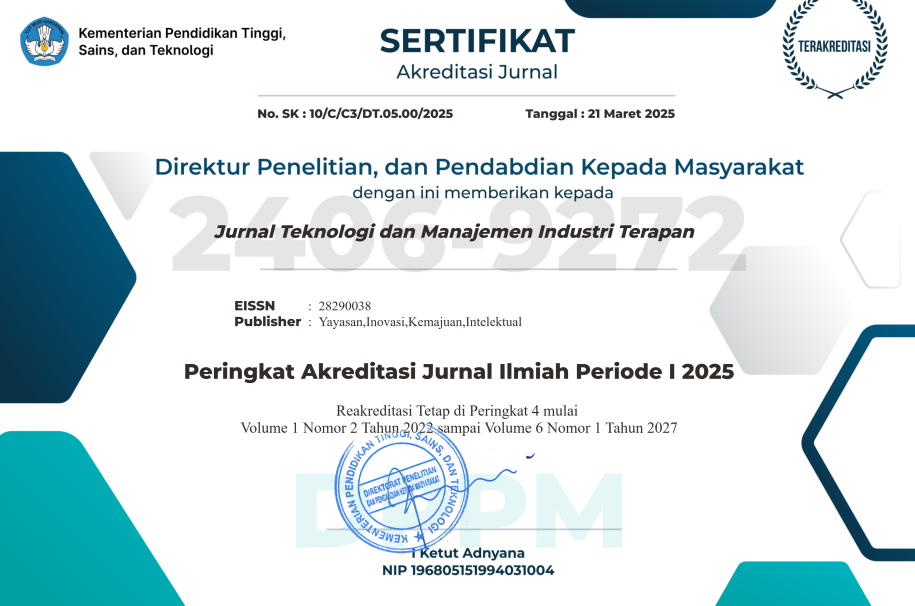Analisis Dan Mitigasi Risiko Produksi Tuts Piano Dengan Metode House Of Risk (HOR) Dan Interpretative Structural Modeling (ISM) Pada Perusahaan Produksi Piano
DOI:
https://doi.org/10.55826/jtmit.v4i3.887Keywords:
Manajemen risiko, House of risk, HOR, Interpretative Structural Modeling, ISM, MICMAC, Mitigasi risiko, Piano, produksi piano, Industri ManufakturAbstract
Penelitian ini menganalisis dan memitigasi risiko produksi tuts piano di perusahaan manufaktur menggunakan metode House of Risk (HOR) dan Interpretative Structural Modeling (ISM). Tujuannya adalah mengidentifikasi risiko yang dapat mengganggu proses produksi, seperti masalah rantai pasokan dan fluktuasi permintaan. Hasil HOR Fase 1 menunjukkan bahwa risiko dominan adalah "Produk tidak sesuai spesifikasi pesanan" (A1), "Takaran lem tidak sesuai" (A6), dan "Mesin sering breakdown" (A17), dengan A6 berada dalam zona risiko kritis. HOR Fase 2 mengembangkan strategi mitigasi, seperti menyusun standar spesifikasi produk (PA1) dan menambah checkpoint inspeksi (PA8), yang diprioritaskan berdasarkan efektivitas. ISM digunakan untuk memetakan hubungan antar faktor risiko dan strategi mitigasi, dengan analisis MICMAC menunjukkan bahwa semua strategi berada dalam kuadran autonomous. Rekomendasi perbaikan mencakup pengeleman yang lebih baik, pergantian pisau mesin terjadwal, pengendalian kualitas material, dan penjadwalan produksi yang efisien, untuk meningkatkan kualitas produk dan efisiensi operasional.
References
T. Jeske, M. Würfels, and F. Lennings, “Development of Digitalization in Production Industry - Impact on Productivity, Management and Human Work,” Procedia Comput. Sci., vol. 180, pp. 371–380, 2021, doi: 10.1016/j.procs.2021.01.358.
I. Setiawan, “Integration of total productive maintenance and industry 4.0 to increase the productivity of nc bore machines in the musical instrument industry,” Proc. Int. Conf. Ind. Eng. Oper. Manag., no. March, pp. 4701–4711, 2021, doi: 10.46254/an11.20210826.
H. Hendra, I. Setiawan, H. Hernadewita, and H. Hermiyetti, “Evaluation of Product Quality Improvement Against Waste in the Electronic Musical Instrument Industry,” J. Ilm. Tek. Elektro Komput. dan Inform., vol. 7, no. 3, p. 402, 2021, doi: 10.26555/jiteki.v7i3.21904.
S. Brezas et al., “applied sciences Review of Manufacturing Processes and Vibro-Acoustic Assessments of Composite and Alternative Materials for Musical Instruments,” 2024.
W. Zou, T. Hin-on, and P. Sapaso, “Implementing practices for the Chinese Nationalized Piano teaching model in undergraduate music education,” Cogent Educ., vol. 11, no. 1, p., 2024, doi: 10.1080/2331186X.2024.2374173.
T. Wakhyudi, M. Sayuti, and K. Karnadi, “Analisis Mitigasi Risiko Kecelakaan Kerja Divisi AC pada Perusahaan Elektronik di Karawang dengan Menerapkan Metode HOR dan ISM,” J. Integr. Syst., vol. 7, no. 1, pp. 83–97, 2024, doi: 10.28932/jis.v7i1.9154.
I. N. Pujawan and L. H. Geraldin, “House of risk: A model for proactive supply chain risk management,” Bus. Process Manag. J., vol. 15, no. 6, pp. 953–967, 2009, doi: 10.1108/14637150911003801.
C. Natalia, Y. F. T. Br. Hutapea, C. W. Oktavia, and T. P. Hidayat, “Interpretive Structural Modeling and House of Risk Implementation for Risk Association Analysis and Determination of Risk Mitigation Strategy,” J. Ilm. Tek. Ind., vol. 19, no. 1, pp. 10–21, 2020, doi: 10.23917/jiti.v19i1.9014.
D. Kristanto and D. A. Kurniawati, “Development of halal supply chain risk management framework for frozen food industries,” J. Islam. Mark., vol. 14, no. 12, pp. 3033–3052, 2023, doi: 10.1108/JIMA-04-2022-0112.
H. Susanto, S. A. Salma, and H. Rahmani, “Risk Mitigation Analysis for Tofu Production Process to Minimize Product Defects Using House of Risk Approach †,” 2025.
N. Syamsiyah, S. R. Qanti, and D. Rochdiani, “Risk Mitigation in Environmental Conservation for Potato Production in Cisangkuy Sub-Watershed, Bandung Regency, West Java, Indonesia,” Agric., vol. 14, no. 10, 2024, doi: 10.3390/agriculture14101726.
H. Zhang, X. Wu, and M. Ju, “Developing a cognitive model of solid geometry based on Interpretive Structural Modeling method,” Heliyon, vol. 10, no. 5, p. e27063, 2024, doi: 10.1016/j.heliyon.2024.e27063.
M. Krivoshapkina, Y. S. Choi, M. Listan Bernal, and G. T. Yeo, “Vitalizing logistics strategies for Tiksi Port using the interpretive structural modelling method,” Asian J. Shipp. Logist., vol. 40, no. 1, pp. 36–41, 2024, doi: 10.1016/j.ajsl.2023.12.004.
P. Jittamai, S. Toek, P. Sathaporn, K. Kongkanjana, and N. Chanlawong, “Risk Mitigation in Durian Cultivation in Thailand Using the House of Risk (HOR) Method: A Case Study of Pak Chong GI Durian,” Sustain., vol. 17, no. 1, pp. 1–19, 2025, doi: 10.3390/su17010222.
D. Arviana and W. Prastika, “Optimalisasi Produktivitas dan Manajemen Risiko pada Sistem Produksi Aleta Leather Menggunakan Metode House of Risk,” vol. 3, no. 2, pp. 160–170, 2024.
P. S. P. C. Oliveira, F. A. F. Ferreira, M. Dabić, J. J. M. Ferreira, and N. C. M. Q. F. Ferreira, “Analyzing the causal dynamics of circular-economy drivers in SMES using interpretive structural modeling,” Energy Econ., vol. 138, no. August, 2024, doi: 10.1016/j.eneco.2024.107842.
M. Rozudin and N. A. Mahbubah, “IMPLEMENTASI METODE HOUSE OF RISK PADA PENGELOLAAN RISIKO RANTAI PASOKAN HIJAU PRODUK BOGIE S2HD9C (Studi Kasus: PT Barata Indonesia),” JISI J. Integr. Sist. Ind., vol. 8, no. 1, p. 1, 2021, doi: 10.24853/jisi.8.1.1-11.
I. Technology and R. Analysis, “JURNAL AKSI Akuntansi dan Sistem Informasi of Risk ( HOR ) for SIAK in Western Seram Regency,” vol. 7, no. 2, pp. 137–147, 2022.
A. Andriyanto and N. K. Mustamin, “Analisis Manajemen Risiko Dan Strategi Penanganan Risiko Pada PT Agility International Menggunakan Metode House Of Risk (Hor),” J. Logistik Bisnis, vol. 10, no. 02, pp. 4–11, 2020, doi: 10.46369/logistik.v10i02.949.
S. Sorooshian, M. Tavana, and S. Ribeiro-Navarrete, “From classical interpretive structural modeling to total interpretive structural modeling and beyond: A half-century of business research,” J. Bus. Res., vol. 157, no. January, 2023, doi: 10.1016/j.jbusres.2022.113642.
R. Attri, S. Grover, N. Dev, and D. Kumar, “Analysis of barriers of total productive maintenance (TPM),” Int. J. Syst. Assur. Eng. Manag., vol. 4, no. 4, pp. 365–377, 2013, doi: 10.1007/s13198-012-0122-9.
V. Jain and H. Qureshi, “Modelling the factors affecting Quality of Life among Indian police officers: a novel ISM and DEMATEL approach,” Saf. Health Work, vol. 13, no. 4, pp. 456–468, 2022, doi: 10.1016/j.shaw.2022.07.004.
A. S. Hariyanto and H. Prassetiyo, “Usulan Pemilihan Supplier Tepung Resin dengan Menggunakan Metode Interpretive Structural Modelling (ISM) dan Analytical Network Process (ANP) di CV Loveina Solid Surface,” pp. 1–10, 2022.
Downloads
Published
Issue
Section
License
Copyright (c) 2025 Adriansyah Dwi Saputra, Muhamad Sayuti, Yuni Syifau, Dicky Suryapranatha

This work is licensed under a Creative Commons Attribution-NonCommercial-ShareAlike 4.0 International License.


















